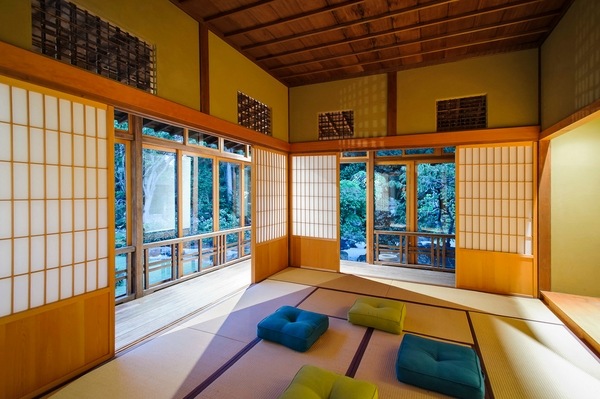The traditional design of the shoji doors features lightweight panels made from thin wooden lattice and pasted sheets handmade Japanese washi paper. Traditionally, Japanese architecture defines shoji as a kind of window or internal partitions made of light transparent, translucent paper which has the ability to pass light, but hide the room. It is made from the fibers of kodazo (mulberry), bamboo, rice or hemp. Paper of a certain thickness beautifully disperses light, creating a delightful atmosphere in the Japanese interior.
The technology of production of washi paper includes a natural bleaching without using any chemicals, so the material is environmentally friendly, firm and elastic. One practical benefit of this door design made from traditional Japanese paper is that in cold weather the cold air from the window, passing through the paper, heats up. Another benefit is the fact that the structure of the washi paper filters out harmful substances and purifies the air. In addition, it absorbs excess moisture and blocks excessive amounts of light into the room.
Sliding door designs in the Japanese style fully retain all the features of the shoji, which, like everything in the culture of Japan, has a special meaning. The ease of transforming the room, the ability to create an open or a secluded space, depending on the particular needs makes them so unique.
Shoji doors – elegance and harmony in your home
Today a small part of the Japanese continues to live in traditional houses but even in modern apartments traditional decorations have their place. Nowadays the Japanese style in the interior is becoming more and more popular and different elements are increasingly gaining immense popularity. It is not surprising at all that many people prefer shoji door designs as they are easy to handle, moreover, they are very beautiful and graceful and provide a perfect flow between interior and exterior spaces or between different areas of the home.
They are perfect as exterior as well as interior door designs. The elegance and the ease of use of the Japanese sliding door ideas is the reason why they are often used in modern interiors. In modern homes, they are a great option to save space in small apartments as they visually increase the space and give lightness and airiness to the atmosphere of the house. Gates in Japanese style harmoniously fit into any interior – both in large living room as room dividers or in small rooms. Shoji door designs are widely used to separate bedroom and bathroom or dressing room, living room and dining area or kitchen.
Modern sliding Japanese exits are rarely made of washi paper due to the fact that the traditional materials do not provide complete sound insulation. Nowadays manufacturers offer various models featuring wood and glass which are more suitable and offer better insulating properties and lower maintenance. However, the design follows the uniqueness of the Shoji door designs and remains unchanged – a lattice frame divided into squares or rectangles by the inserts.
Shoji doors bring the Japanese minimalism in the interiors of modern homes
Japanese style is characterized with striking simplicity and functionality, harmony and appreciation of the beauty in the surrounding world and nature. Traditional homes seldom have structural interior walls separating the space into different rooms as they are replaced by sliding door designs. You will not see an interior swing door in a traditional Japanese house and when you think of decorating your home in this style, you need to keep that in mind. An option is to choose folding or accordion types and with a proper design they can be blended into a Japanese décor. As mentioned above, it is advisable to avoid solid wood and choose lighter materials. Remember that light has a huge role as it creates harmony in the house. Frosted glass inserts are a good choice for modern homes as they will provide a good light flow and will offer the appearance of a Shoji door.
When choosing the colors you may opt for matching neutral shades or contrasts, as Japanese interiors are often based on creating visual contrasts. Wenge, black or gray gates will stand out against white or light wall colors, while white and neutral shades of the door frame will contrast to saturated and dark wall colors. The shades that you need to avoid are yellow, red and red-brown as they are not typical for the Japanese style.
The biggest advantage of shoji door designs is, of course, the space saving. This is very important for small apartments or houses where every inch is precious. Japanese sliding door ideas are practical, comfortable and provide a long service. They are both simple and elegant and will be the ideal option for everyone who loves the combination of luxury and simplicity.


















